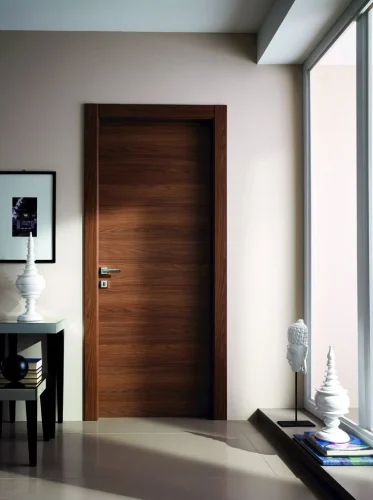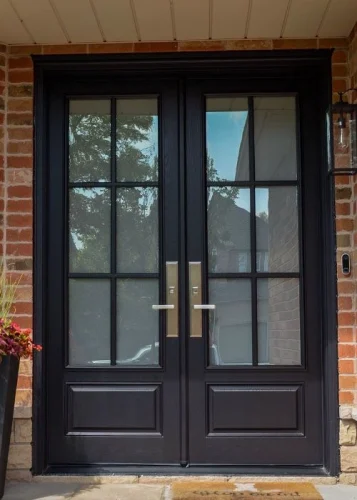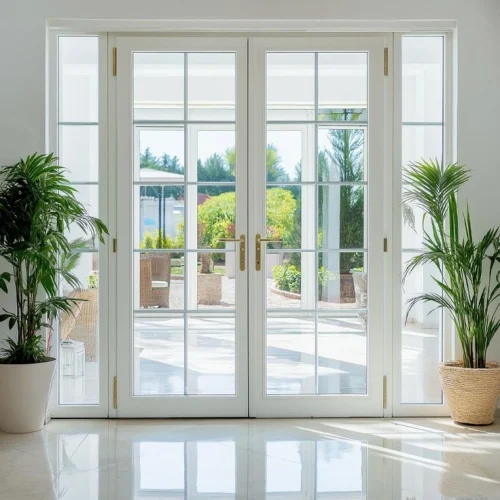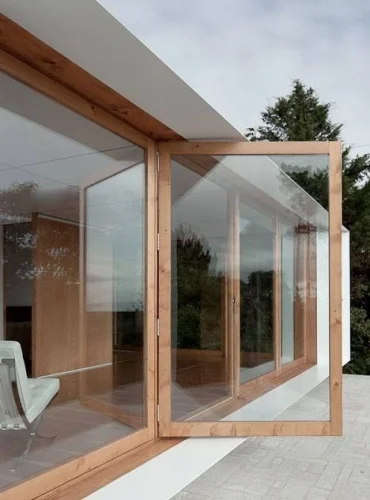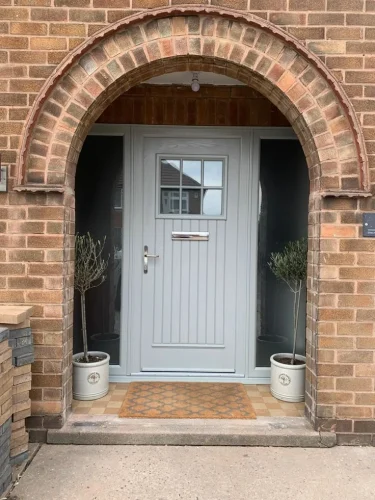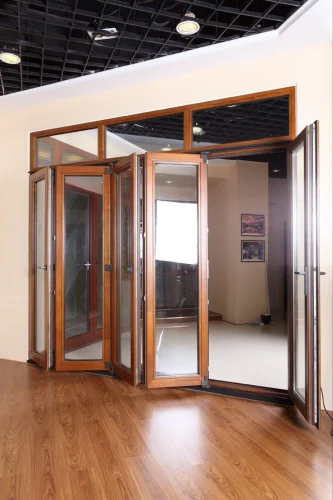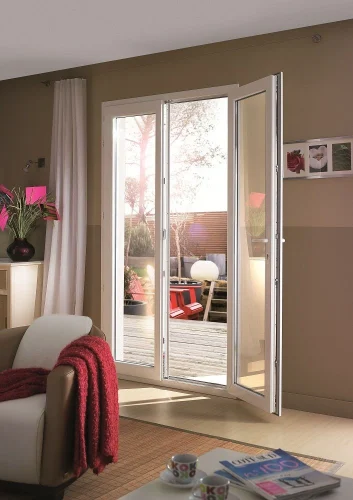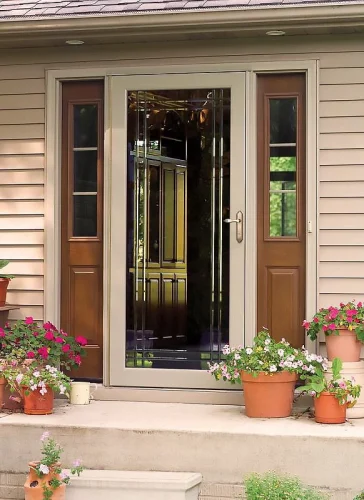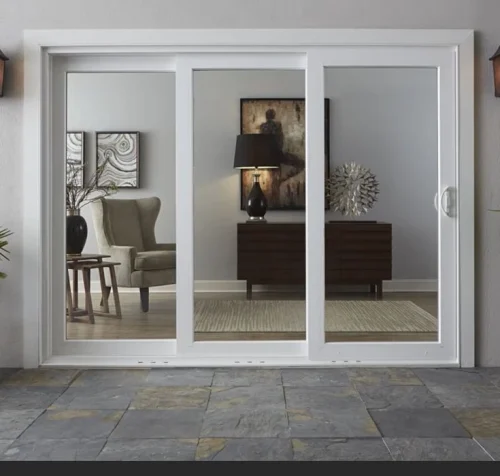Best Insulated Door Options For Homes
Here are some of the best insulated door options for your home.
1. Insulated wooden doors

The solid-core wooden doors come with foam or polyurethane insulation inside. They look premium and are best for main entrances, bedrooms and interior doors. Just make sure you pick hardwood like teak, oak, or engineered wood for durability.
Pros:
- Naturally good insulation
- Good soundproofing
- Stylish and classic
- Modern designs come with weatherstripping to seal gaps
Cons:
- Require maintenance (polish/paint)
- Can warp if untreated
2. Steel insulated doors

If you are looking for the best thermal insulated doors, steel is the one for you.
Steel doors come with an insulated foam or polystyrene core inside. They are perfect for main entrances, garages, and side doors, as they are sturdy, weather-resistant, and excellent for harsh climates. Just make sure to check for thermal breaks to prevent heat transfer.
Pros:
Cons:
- Prone to dents
- Needs rust-resistant coating for very humid areas
3. Fiberglass insulated Doors

Fibreglass insulated door options have a foam core inside and are more weather-resistant than wood. They have a solid insulated core, are energy efficient, and stand up well to humidity and temperature changes. They are perfect for main entrances, back doors, and patios.
Pros:
- Won’t warp or rust
- Good insulation and soundproofing
- Low maintenance
Cons:
- Higher upfront cost than basic wooden doors
- Needs professional installation for best sealing
4. uPVC doors with insulated panels

uPVC doors with insulated panels or double/triple glazing offer solid thermal performance and easy maintenance. They are best for balconies, backyards, and interior doors. If you want a premium wood-like finish, make sure to opt for laminated uPVC doors.
Pros:
- Blocks heat, noise and cold
- Great for soundproofing and thermal insulation
- Weather and termite resistant
- Easy to maintain
Cons:
- Can look plain if not designed well
- You cannot expect to find different styles/colours/design options with all the service providers.
At GreenFortune, you don’t have to worry about boring doors. Our uPVC doors come in many colours, styles, and wood-like finishes. They keep heat, cold, and noise out and stay strong for years. They don’t rust or get termites.
Check out our uPVC collection!
5. Insulated glass doors

Glass alone is not insulating, but double/triple glazing with inert argon gas filling and thermal breaks makes it energy efficient. Insulated glass doors are perfect for balconies, patios, and French doors.
Pros:
- Modern, airy look
- Lets in natural light
- Good insulation with the right glazing
Cons:
- Expensive for large openings
- Needs precise installation
6. Aluminium insulated doors

Aluminium as a material is naturally conductive, but modern aluminium doors use thermal breaks, i.e., layers of non-conductive materials inside the frame to block heat flow. They are perfect for patios, modern main entrances, and sliding doors. Just make sure to choose thermally broken aluminium frames with double/triple glazing for maximum efficiency.
Pros:
- Sleek, modern appearance
- Strong yet lightweight
- Durable and easy to maintain
Cons:
- Needs thermal breaks to avoid condensation
- Slightly expensive than uPVC doors
Also read: 8 common myths about heat-proof glass!
7. Composite doors

Popular in Europe for extreme climates, composite doors are made with a mix of materials, like wood, uPVC and insulated foam to give the maximum strength, insulation and style. If yours is a high-end home, and you want a ‘best of all worlds’ door, it is a perfect option for your front door.
Pros:
- Excellent thermal insulation
- Highly secure
- Good weather resistance
Cons:
- More expensive than all single-material doors
- May need expert installation
8. Metal-clad wooden doors

Metal-clad wooden doors have a solid wood core clad with a metal layer (steel or aluminium) on the outside for weather protection and added security. They are most suited for main doors and modern villas.
Pros:
- Gives warmth of wood and durability of the metal
- Good thermal insulation
- Stylish and secure
Cons:
- Costs higher than plain wood and steel
- Limited suppliers
9. PVC doors

PVC doors are lighter and cheaper, but have lower insulation than uPVC. So, they are best for indoor use only. Go for it if you are on a tight budget, just for internal doors.
Pros:
- Budget-friendly
- Easy to maintain
Cons:
- Not ideal for external door usage
- Less thermal and acoustic performance
How To Choose The Right Insulated Door Options For Your Home?

By room
- Main door: Steel, composite, or fibreglass for security + insulation
- Bedroom/study: Solid-core wood or composite for warmth + soundproofing
- Balcony/patio: uPVC, insulated glass, or aluminium with thermal break
- Garage/utility: Steel, metal-clad wood, or composite for weather resistance
By local climate
- Hot/humid: Fibreglass, uPVC, aluminium (thermally broken), no warping or rust
- Cold: Composite, insulated steel, triple-glazed glass for high R-value
Soundproof door for home
- Solid-core wood, composite, or metal-clad doors
- Add acoustic seals + door sweeps
By budget
- Affordable: Solid wood, uPVC
- Mid-range: Fibreglass, aluminium with thermal break
- Premium: Composite, metal-clad wood
Checklist For Insulated Door Options

No matter the material you choose, make sure your energy efficient doors have
- Proper core insulation (foam, polystyrene, or polyurethane)
- Quality weatherstripping to seal air leaks
- Thermal breaks for metals like aluminium or steel
- Double/triple glazing for glass inserts
- A well-fitted frame with no gaps.
You might also be interested: Smart rooftop cooling solutions to beat the heat!











